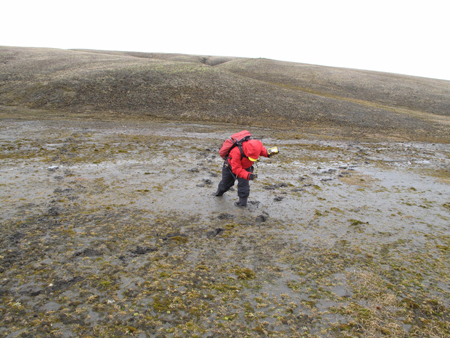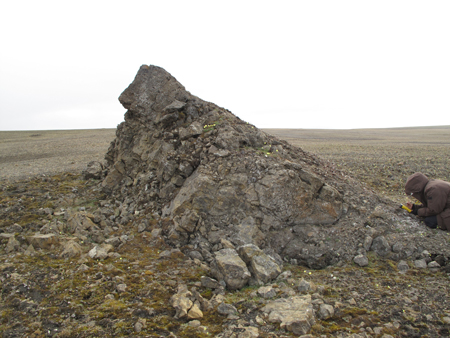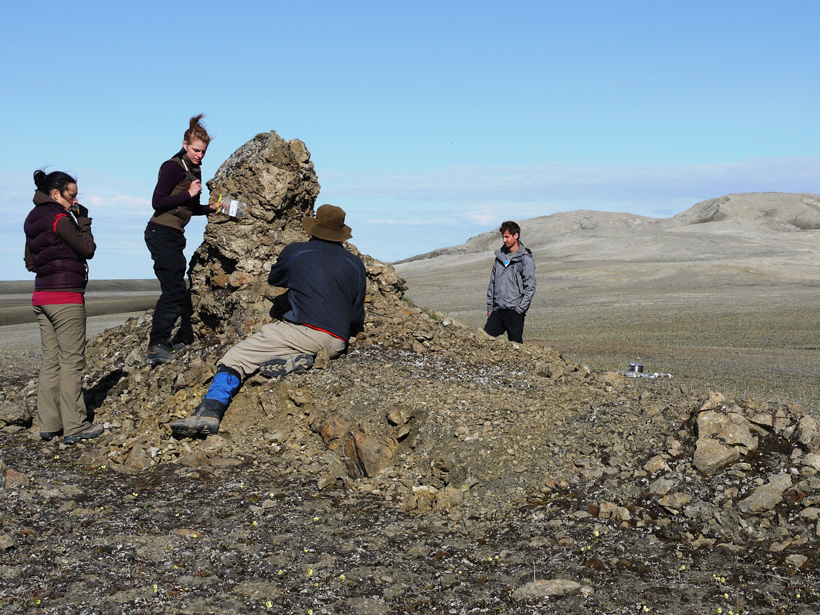Krista Williscroft and her colleagues trudged for days through mud, often up to their knees, cataloging large mounds of rock across a desolate landscape. Constant sunlight, a light breeze, and temperatures hovering around freezing on Ellef Ringnes Island made for a pleasant field campaign—at least, as pleasant as it could get for the Canadian High Arctic.
The researchers were studying 2-meter-tall rocky mounds that they later learned were left by ancient methane seeps whose gas bubbled out of an ocean floor 110 million years ago. During two summers exploring 10,000 square kilometers of flat, shale-topped island, Williscroft and her colleagues found 139 of the mounds, the most expansive geological evidence discovered so far on Earth of ancient methane seeps.
“What we see then is there’s a sudden appearance of all these methane mounds [at] the exact time that the Earth was going through this global warming event.”
The mounds appear to have grown during one of Earth’s warmest periods in the past 200 million years, called the Cretaceous Thermal Maximum. Their discovery, reported last month in the Geological Society of America Bulletin, indicates that a warming climate can unlock methane—a greenhouse gas 20 times more potent than carbon dioxide—that has been trapped deep in the ocean, locked in icy cages known as methane hydrates.
“What we see then is there’s a sudden appearance of all these methane mounds [at] the exact time that the Earth was going through this global warming event” during the Cretaceous period, said Steve Grasby, a geochemist at the Geological Survey of Canada in Calgary and coauthor on the new paper.
Although the researchers can’t say for certain how the seeps affected their ocean environment—much less Earth’s climate at the time—it’s clear they represent “sudden releases of methane related to warming,” Grasby said.
Methane Mounds Abound
Much of Earth’s methane is locked in molecular cages of water ice, forming methane hydrates. Scientists estimate that most methane hydrates occur on the ocean floor, along continental margins. If the methane hydrates melt, the gas is released into the ocean, creating a habitable environment for certain microbial populations that can metabolize the methane for energy. These chemical reactions produce carbonate, which builds up until a rocky mound appears, similar to how microbes at hydrothermal vents create “black smoker” structures.

The researchers already knew that one remnant of a methane seep existed on the island. In the 1970s, Benoit Beauchamp, a coauthor on the new paper and a geochemist also at the University of Calgary, spotted one and took a sample during a research trip. The rock sample sat on his desk for 20 years before one of Grasby’s colleagues decided to analyze its chemistry and found something strange.
Normally, the carbon found in marine carbonate (primarily in the form of limestone) has a specific ratio of carbon-13 and carbon-12 isotopes. But this carbonate had an unusual abundance of the lighter isotope. Researchers know that methane coming from organic material, such as long-dead organisms packed under ocean floor sediment, contains a higher abundance of carbon-12. Because of the rock sample’s enrichment of carbon-12, the researcher concluded that the mound could have been formed only by a methane seep, Grasby said, where microbes metabolized methane and released a carbonate by-product that built up the mound.
So in 2010, Grasby, lead author Williscroft (who was a graduate student at the time but is now a geologist at Nexen Energy), and a team of researchers traveled to the remote island to study Beauchamp’s mound. That July, Williscroft stood next to the mound, taking notes on its crystals and small, embedded fossils: tube worms, clams, ammonites, and more. Then, gazing over the flat, gray terrain, she and her colleagues noticed some bumps poking out of the shale along the horizon and decided to explore.
Research Turned Adventure
“Within 3 days of being on the island my whole plan changed to much more an adventure and exploration in finding these.”
Immediately, the researchers suspected that these mounds were also made from microbe-built carbonate because of their characteristic banding patterns and fossils that don’t show up in the surrounding shale, Williscroft said. So the researchers walked farther and spotted even more mounds.
“Within 3 days of being on the island my whole plan changed to much more an adventure and exploration in finding these,” Williscroft said.
Each day at the crack of dawn (metaphorically, as the Sun never set), Williscroft and her colleagues hopped into a helicopter to be dropped off at various places on the island, where they spent hours walking, spotting the mounds, and cataloging them. After the 2010 expedition and an additional trip in the summer of 2011, it became obvious that there were possibly hundreds of mounds sprawled across the island, Williscroft said.

Back in Calgary, the team analyzed the carbon isotopes in their samples, finding a ratio of enriched carbon-12 that indicated a methane-related origin. In rocks older than the methane seeps, the researchers also found a mineral called glendonite, which forms in cold temperatures, Grasby said. This mineral find indicated that before the methane seeps formed 110 million years ago, the environment was cold, which may have allowed the methane hydrates to form. But something, perhaps warming on a global scale, melted any existing methane hydrates and launched the microbial process that built the methane seep mounds.
Climate Change Lessons
The finding shows that “methane gas hydrates can release methane in a real geological environment,” said Jacek Majorowicz, a geophysicist at the University of North Dakota in Grand Forks, who was not involved in the research.
Because methane hydrates concentrate methane about 100 times more densely than methane gas, some researchers suggest that liberating just a small number of methane molecules from their icy cages could have a large effect. As the climate warms today, these methane hydrates in the oceans could melt, releasing gas into the oceans and even atmosphere. The gas could “act as another feedback to increase the greenhouse effect into the future,” Majorowicz said.
—JoAnna Wendel (@JoAnnaScience), Staff Writer
Citation:
Wendel, J. (2017), Ancient methane seeps tell tale of sudden warming, Eos, 98, https://doi.org/10.1029/2017EO073029. Published on 05 May 2017.
Text © 2017. The authors. CC BY-NC-ND 3.0
Except where otherwise noted, images are subject to copyright. Any reuse without express permission from the copyright owner is prohibited.

